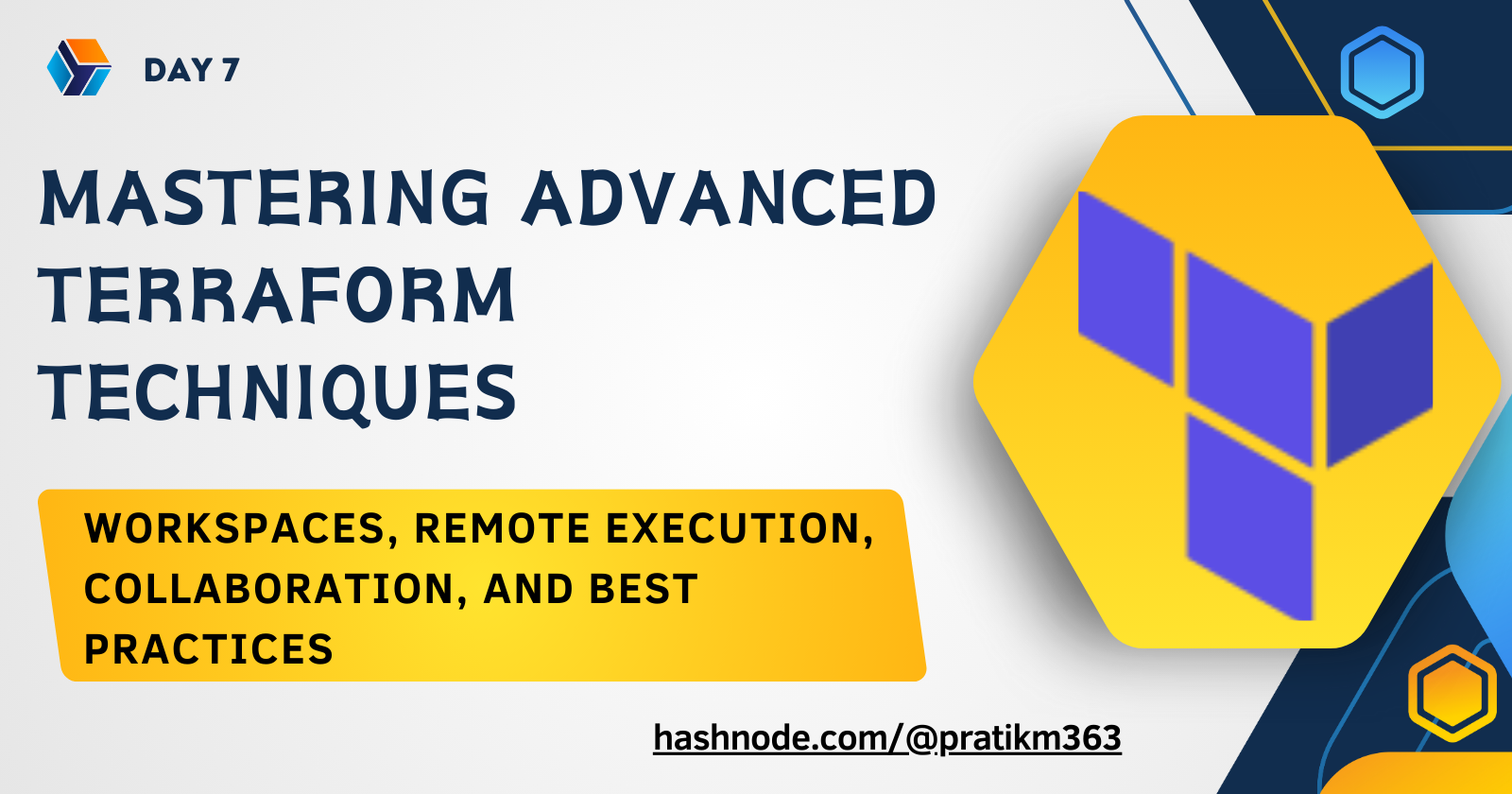📙Mastering Advanced Terraform Techniques: Workspaces, Remote Execution, Collaboration, and Best Practices
 Pratik R. Mandge
Pratik R. Mandge
📌Workspaces, Remote Execution, and Collaboration
1. Workspaces:
Workspaces in Terraform allow you to manage multiple environments (such as development, staging, and production) with the same configuration.
Each workspace has its state file, allowing you to apply changes independently to different environments.
Use the
terraform workspacecommand to create, select, list, and delete workspaces.
2. Remote Execution:
Remote execution in Terraform involves storing your state file remotely, which provides several benefits:
Improved collaboration: Team members can work on the same infrastructure without conflicts.
State locking: Prevents concurrent runs from modifying the same resources simultaneously.
Backup and recovery: State files are stored securely and can be restored if necessary.
Common remote backends include AWS S3, Azure Storage Account, Google Cloud Storage, and HashiCorp Consul.
3. Collaboration Tools:
HashiCorp Terraform Cloud and Terraform Enterprise are collaboration platforms that provide additional features for managing Terraform configurations and infrastructure:
Version control: Track changes to your infrastructure over time.
Policy as code: Enforce organizational policies using Sentinel.
Secure variable storage: Store sensitive data securely, such as API tokens and passwords.
Benefits of Using Workspaces, Remote Execution, and Collaboration Tools:
Simplified environment management: Manage multiple environments with ease.
Enhanced collaboration: Team members can work together more effectively.
Improved security and reliability: Remote execution and collaboration tools provide better security and reliability for your infrastructure.
📌Terraform Best Practices
1. Code Organization:
Use meaningful directory structures to organize your Terraform code.
Separate your code into reusable modules for better maintainability.
Use variable files (
variables.tf) to define input variables and keep them separate from the main configuration.
2. Module Usage:
Use modules to encapsulate related resources and promote reusability.
Define clear interfaces for your modules to make them easy to use and understand.
3. Naming Conventions:
Follow naming conventions for resources, variables, and modules to ensure consistency.
Use descriptive names that reflect the purpose of the resource or module.
4. Version Control:
Use a version control system like Git to manage your Terraform code.
Commit frequently and use descriptive commit messages to track changes effectively.
Use branches for feature development and merge changes using pull requests.
5. CI/CD Integration:
Integrate Terraform with your CI/CD pipeline for automated testing, validation, and deployment.
Use Terraform's
terraform plancommand to preview changes before applying them.Use Terraform's
terraform validatecommand to check your configuration for syntax errors and other issues.
6. Infrastructure as Code (IaC) Principles:
Treat your infrastructure code like application code, applying the same software engineering best practices.
Use version control, code reviews, and automated testing to ensure the reliability and maintainability of your infrastructure.
7. Security Best Practices:
Store sensitive information such as access keys and passwords securely.
Use encryption to protect sensitive data in transit and at rest.
📌Exploring Additional Features
1. Terraform Cloud / Terraform Enterprise:
Terraform Cloud is a SaaS platform by HashiCorp that provides collaboration, infrastructure management, and automation features for Terraform.
Terraform Enterprise is an on-premises version of Terraform Cloud, offering the same features but hosted on your own infrastructure.
Key features include:
Collaborative workspace: Allows teams to work together on Terraform configurations, share state, and manage access.
Version control integration: Integrates with version control systems like Git for versioning and change tracking.
Run triggers: Automatically triggers Terraform runs in response to changes in your version control system.
Sentinel policy as code: Enforces governance policies and best practices using Sentinel.
Cost estimation: Provides cost estimates for your infrastructure changes before applying them.
2. Terraform Registry:
The Terraform Registry is a public repository of Terraform modules and providers maintained by HashiCorp and the community.
It allows you to discover and use pre-built modules and providers to extend the functionality of your Terraform configurations.
Key features include:
Modules: Reusable packages of Terraform configurations that encapsulate infrastructure resources.
Providers: Plugins that enable Terraform to interact with different infrastructure platforms and services.
Published modules and providers undergo a review process to ensure quality and security.
How to Explore:
Sign up for a Terraform Cloud account or set up Terraform Enterprise to explore their features and capabilities.
Visit the Terraform Registry website to browse modules and providers and learn how to use them in your configurations.
I think this blog will be quite valuable, offering unique viewpoints and introducing new and engaging ideas. 🙏
Happy Terraforming! 🌍💻
📌Copyright © Pratik R. Mandge, 2024. All rights reserved.
This article and its content are protected by copyright law. Reproduction or distribution of this article without the author's permission is prohibited. For inquiries, please contactpratikmandge021@gmail.com
Subscribe to my newsletter
Read articles from Pratik R. Mandge directly inside your inbox. Subscribe to the newsletter, and don't miss out.
Written by

Pratik R. Mandge
Pratik R. Mandge
Hey there! 👋 I'm Pratik R. Mandge, a DevOps Engineer passionate about all things AWS DevOps Technology. Currently on a learning adventure, I'm here to share my journey and Blog's in the world of cloud and DevOps. 🛠️ My focus? Making sense of AWS services, improving CI/CD, and diving into infrastructure as code. Whether you're fellow interns or curious enthusiasts, let's grow together in the vibrant DevOps space. 🌐 Connect with me for friendly chats, shared experiences, and learning moments. Here's to embracing the learning curve and thriving in the exciting world of AWS DevOps Technology! Follow me on LinkedIn: https://www.linkedin.com/in/pratik-mandge363